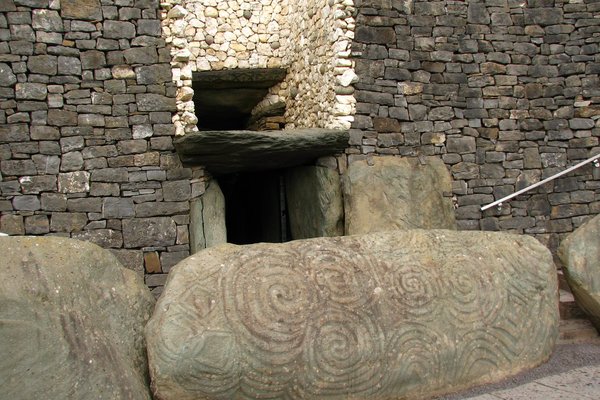Ireland
Brú na Bóinne
Brú na Bóinne - Archaeological Ensemble of the Bend of the Boyne comprises the largest collection of remains from the Neolithic era in Europe.
The site was an important ritual centre until the Late Middle Ages. The dozens of megalithic monuments had funerary and ritual use. It is especially valued for its passage graves adorned with petroglyphs, with Newgrange, Knowth and Dowth as the best examples.
Community Perspective: The main site of Newgrange is often included in day tours from Dublin, and can become busy. Knowth is a good (some say: even better) alternative, while at Dowth the interior of the graves cannot be visited but it provides a look at an unreconstructed tomb. The other graves can only be entered with a guide.
Site Info
Official Information
- Full Name
- Brú na Bóinne - Archaeological Ensemble of the Bend of the Boyne (ID: 659)
- Country
- Ireland
- Status
-
Inscribed 1993
Site history
History of Brú na Bóinne
- 2013: Name change
- "Brú na Bóinne" - added
- 1993: Inscribed
- Inscribed
- Type
- Cultural
- Criteria
- i
- iii
- iv
Links
- UNESCO
- whc.unesco.org
- Official
-
- worldheritageireland.ie — World Heritage Ireland
- Related
-
- megalithomania.com — Link
- knowth.com — Link
All Links
UNESCO.org
- whc.unesco.org — whc.unesco.org/
Official Website
- worldheritageireland.ie — World Heritage Ireland
Related Resources
- megalithomania.com — Link
- knowth.com — Link
News Article
- Dec. 13, 2019 irishcentral.com — State-of-the-art visitor center opens at Newgrange just in time for the Winter Solstice
- Dec. 22, 2018 irishpost.com — 'Remarkable archaeological discoveries' made at Irish world heritage site Newgrange revealed to mark winter solstice
- Nov. 9, 2018 forbes.com — 60 Lucky Lottery Winners To Visit Tomb Older Than Stonehenge And Egypt's Pyramids
- July 17, 2018 thejournal.ie — 'The find of a lifetime': Megalithic passage tomb dating back 5,500 years found in Co Meath
- July 12, 2018 irishtimes.com — Scorched earth during heatwave reveals new monument at Newgrange
- Sept. 11, 2013 herald.ie — New tomb and passage found at Newgrange
- Oct. 21, 2011 independent.ie — Search on for a second passage in Newgrange
- March 16, 2007 belfasttelegraph.co.uk — The prehistoric World Heritage sites at the Boyne and Newgrange will be overlooked by a giant smokestack attached to an incinerator in Co Meath.
Community Information
- Community Category
- Archaeological site: Prehistoric
Travel Information
Guided Tour Only
Recent Connections
-
Works by Nobel Prize winning authors
Seamus Heaney (1995) - "Funeral Rites" … -
Untranslated Toponyms
"Brú" in Gaelic means "Palace" or "Mans… -
Named after a River
Brú na Bóinne - River Boyne. Originally…
Connections of Brú na Bóinne
- Trivia
-
-
Depicted in Mizielinska Maps
NewgrangeSee i.pinimg.com
-
- History
-
-
Celtic history
Celtic graves -
Iron Age
defense ditches around the central mound in Knowth -
Neolithic age
"The Knowth group, where the earliest features date from the Neolithic period and the latest from the Anglo-Norman period, has produced thirty monuments and sites" (OUV) -
Buried treasures
A treasure of Roman coins and other artefacts was retrieved in Newgrange. -
Located in a Former Capital
Knowth served as the capital of Brega in the 9th century. It became the capital of united Ireland in the 10th century under Cormac MacMaelmithic. -
Megalithism
The Brú na Bóinne monuments represent the largest and most important expression of prehistoric megalithic plastic art in Europe. (OUV) -
Oldest Buildings
3200BC Newgrange "Passage Tomb"/Temple
-
- Architecture
-
-
Restored by anastylosis
Newgrange -
Earth Architecture
Newgrange : henge
-
- Damaged
-
-
Iconoclasm
Four Christian kings of Brega desecrated the central mound of Knowth during the 9th century.
-
- World Heritage Process
-
-
First inscriptions
Ireland 1993 -
Perfect Inscriptions
1993
-
- Religion and Belief
-
-
Cistercian
Newgrange was the grange of a Cistercian Monastry
-
- Human Activity
-
-
Historical Graffiti
"There is evidence to show that Newgrange was plundered by Danish raiders about the year 860. Graffiti in the tomb dates back to the 7th century, a subject of great interest to historians." At Knowth as well. Also: Newgrange was re-discovered in 1699, visitors scratched their names. -
Secret Locations
Numerous underground passages were probably used as shelter during battles. -
Petroglyphs
-
- Constructions
-
-
Timber circles
Newgrange -
Cycoliths (Stone circles)
A circle of standing stones also surrounds Newgrange. .. excavation have shown that one of the stones of the circle lies directly on top of the Early Bronze Age Pit Circle. (see link) -
Passage of the Sun
Newgrange has a remarkable Winter Solstice event -
Tumuli
-
Purpose Built Visitor Centre
Buffer Zone 1997See www.knowth.com
-
- WHS on Other Lists
-
-
UNESCO Intangible Cultural Heritage Lists
Art of dry stone construction, knowledge and techniques (2024)See ich.unesco.org
-
- Timeline
- Science and Technology
-
-
Astronomy and Astrology
A large phallic stone was found in the outskirts of the Great Mound in Knowth. One of the theories suggests that it was used to follow the movements of Venus
-
- Visiting conditions
-
-
Guided Tour Only
Tours start at the visitor centre, and the visitors are being taken to Newgrange etc by shuttle bus -
Unusual Entry Requirements or Restrictions
New Grange tomb. Entry on the day of the winter solstice is limited to c 50 winners of a lottery (from some 30000+ applicants!).
-
- WHS Names
-
-
Name changes
"Brú na Bóinne -" added (2013) -
Named after a River
Brú na Bóinne - River Boyne. Originally inscribed simply as "Archaeological Ensemble of the Bend of the Boyne". The Gaelic "Brú na Bóinne" was added in 2013 and translates as "palace" or "mansion" of the Boyne. -
Untranslated Toponyms
"Brú" in Gaelic means "Palace" or "Mansion". "Medieval texts preserve the term Brug na Bóinde (‘mansion/place of hospitality of the Boyne’) which seems to have encompassed a complex of sites in the immediate vicinity of Newgrange, although originally it may have referred exclusively to the Newgrange mound". Linkage of the Neolithic sites of the area to places and stories in early Irish mythology grew stronger through the 19th/20th centuries and was "cemented" by adding the Gaelic name to the originally inscribed one in 2013 and framing the site's marketing and visitor experience around that term.
-
- Literature & Film
-
-
Works by Nobel Prize winning authors
Seamus Heaney (1995) - "Funeral Rites" in volume North
-
News
- irishcentral.com 12/13/2019
- State-of-the-art visitor center op…
- irishpost.com 12/22/2018
- 'Remarkable archaeological discove…
- forbes.com 11/09/2018
- 60 Lucky Lottery Winners To Visit …
Recent Visitors
Visitors of Brú na Bóinne
- Adrian
- Albert
- Alberto Rodriguez Gutierrez
- Alexander Barabanov
- Alexander Lehmann
- Alex Baranda
- Alex Goh
- Alikander99
- Ali Zingstra
- Allan Berry
- ALS
- A. Mehmet Haksever
- Ana
- Anne
- Argo
- arnaugir
- Artur Anuszewski
- Assif
- Astraftis
- Atila Ege
- AustralLights
- awestix
- Badwater
- Bamse
- basementonline
- BaziFettehenne
- Bill Maurmann
- Birgitte Sørensen
- Bram de Bruin
- Brendan Carroll
- Bropyk
- brornt
- c82wc1
- campmany
- Carlos Sotelo
- Cezar Grozavu
- ChrisN
- Christer Sundberg
- Christoph
- Christravelblog
- ClaraHH
- Clyde
- Cobaltrage
- Cody Ayers
- Colossus
- Coppi
- Crinion
- Cristina Erba
- Csaba Nováczky
- czesioszpachelka
- Dani Cyr
- Daniela Hohmann
- Daniel Chazad
- David Berlanda
- debatecoach
- Dennis Nicklaus
- Digits
- Dimitar Krastev
- Dirk-pieter
- Dolemite92
- Dorejd
- DouglasR
- Dr. Caligari
- Dreamcatcher
- Echwel
- Elaine McArdle
- Elena Y
- Els Slots
- Erik Jelinek
- Errol Neo
- Ertai
- Eva Kisgyorgy
- fabi-ddorf
- Fan Yibo
- Feldhase
- Felicité
- Filip Murlak
- flahr
- FS
- Gary Arndt
- George Gdanski
- GeorgeIng61
- GerhardM
- Gilles
- Grendel Gongan
- grimloch
- Grzegorz Andruszkiewicz
- Harald T.
- Harry Mitsidis
- henrik_hannfors
- Hurrvinek
- Iain Jackson
- Ian Cade
- Ilya Burlak
- Ivan Rucek
- Jacob Choi
- Jacob Otten
- Jakob F.
- James Bowyer
- Janina Lehmann
- Jan Zimmermann
- Jawnbeary
- Jay T
- jcleek27
- Jean Lecaillon
- Jeanne OGrady
- Jens
- Jezza
- Joel on the Road
- Jonas Hagung
- Jonas Kremer
- jonathanfr
- Jon Eshuijs
- Joyce van Soest
- Just_hatched
- jxrocky
- KarenBMoore
- Kasper
- KeithBailey
- kiank37
- kjluebke
- Knut
- Kurt Lauer
- Laetitia Yin
- Lameduck99
- Lara Adler
- Little Lauren Travels
- ljowers
- Loic Pedras
- Luboang
- Luis Filipe Gaspar
- Lukemarshall
- Maciej Gil
- Martina Rúčková
- Marty
- maryhattie
- Matthewsharris
- MAURO PODDA PANI
- mg:1
- MH
- MichaelH
- Michael Turtle
- Mihai Dascalu
- Mikko
- Mikko Syrjä
- Milan Jirasek
- MMM
- Mohboh
- Mstrebl1990
- nan
- Nicole Lampos
- Nihal Ege
- Olli-Pekka Turunen
- PabloNorte
- Patrik_globe
- peacemaker2142
- PeterH
- Peter Lööv
- Petteri
- Philipp Leu
- Philipp Peterer
- pressdm
- Randi Thomsen
- Reza
- RobRos
- Roel Sterken
- Roger Ourset
- Roman Bruehwiler
- Roman Raab
- Ronbon
- Rudegirl
- Sabrina Liebehentschel
- Samy G
- sandersx2
- sbshipway
- scubarrie
- Sehnsuchtsbummler
- Sergio Arjona
- Shandos Cleaver
- Solivagant
- Stan
- Stanislaw Warwas
- stephanvermeulen
- Svein Elias
- Szucs Tamas
- Tamara Ratz
- Taotao Chen
- Tarquinio_Superbo
- Tatiana Nikulnikova
- TheDarlingLife
- Thomas Buechler
- Thomas van der Walt
- Tim Allen
- Tom Flaten
- Tommy W
- Tony H.
- Traveling Girl
- travellingcat
- Truls Brekke
- Tsunami
- Twobaconsandaboston
- ValiaVeweth
- Van Hung
- Vernon Prieto
- Viaje al Patrimonio
- Vincent Cheung
- WalGra
- WILLIAM RICH
- Wojciech Fedoruk
- Yi Han Goh
- Zizmondka
- Zoë Sheng
Community Reviews
Show full reviews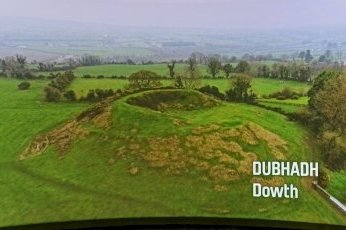
We visited Brú na Bóinne in June 2022 but didn’t post a review as there are plenty already. However, I now note that no one has yet described the Mound at Dowth and that a couple of the references made about it in earlier reviews are not quite correct so, here goes -
a. Dowth is the 3rd large mound (of similar size to the others) within the Brú na Bóinne complex after the more famous Newgrange and Knowth. Unlike them it has never been “reconstructed” and doesn’t form a part of the tours on offer at the Brú na Bóinne Visitor Centre. It can however be visited externally independently without paying or booking. I have provided an aerial photo taken from a Visitor Centre video because it gives a better idea than any of my own close ups of what the mound looks like as a whole. That might be regarded as somewhat “underwhelming”!! Nevertheless, as I try to identify below, it has its interests and merits - although no one could argue that you should visit it in preference to the other 2 mounds if you had never seen, or could get to, them. If you couldn’t get a tour ticket however, you might do so in order to get that “WHS tick” by entering the inscribed area somewhere!.
b. Assuming that you have had your “fill” of Knowth and Newgrange, a further reason to go to Dowth is as an “antidote” to the previous experience! …
Keep reading 0 comments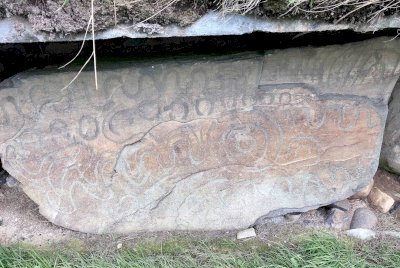
Visited this site in September 2019. We arrived on Monday and there were not many people. Visitor center is still under refurbishment (the guide told that probably only 2-3 weeks are left to complete the works). We received free tickets to Knowth and Newgrange and visited both.
Knowth comprises one large mound and 18 surrounding small mounds. Two passage tombs are not accessible to tourists (only a glimpse into one of the passages), but there is a showroom, where the video demonstrates the impressive interior of the passage. Large mound’s perimeter is circled with 127 big stones, many of which are nicely carved. The guides specifically emphasize that the site has been continuously used from the ancient times until the late medieval period (and of course, the remind that these tombs are older than the pyramids). Knowth also has a reconstruction of timber monument probably used for rituals. It is possible to climb the large mound and enjoy a beautiful view to the surrounding green valleys.
Newgrange is a single large passage tomb with 97 kerbstones with richly decorated main entrance stone; however, other stones are not so well carved as at Knowth. The highlight is 5,000-year-old passage, 19 meters long with a bit narrow stretch at the beginning, leading to a chamber with round roofs and three tomb chambers. The guide highlighted that after 5,000 years of Irish rains the roof has been still water proof! Inside stones have both historical visitors’ graffiti and ancient spiral carvings. …
Keep reading 0 comments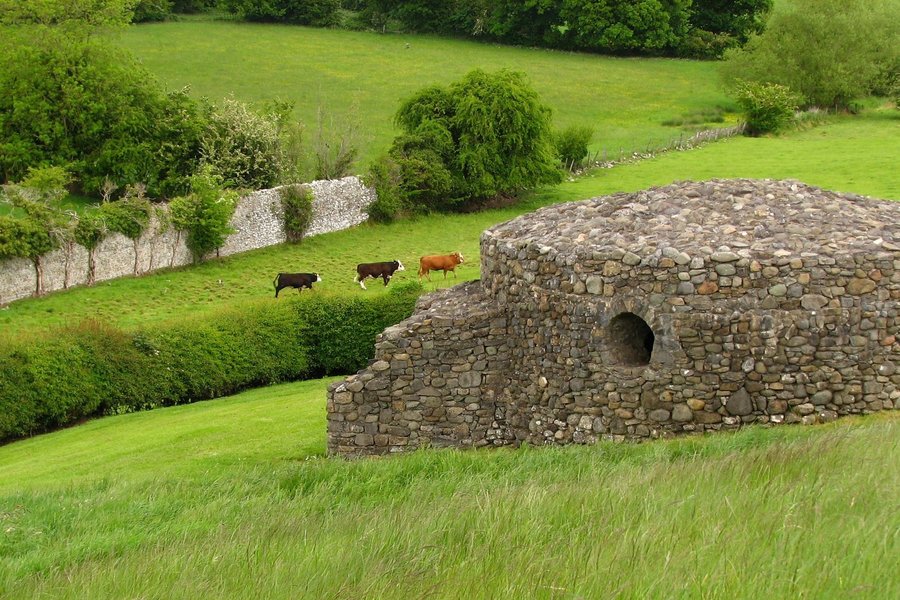
When visiting the complex of Bru na Boinne xI was impressed how well preserved the site was. It was not something I had expected from a site that old. I also learnt some interesting facts regarding the sites that are not normally mentioned:
1) The complex is the second largest concentration of neolithic art in the world (after the WHS Neolithic Orkney). As most of the art is presented on large stone slabs it is dubbed the largest concentration of megalithic art in the world.
2) One of the carvings presents a whale. I couldn't find any information as to whether whales lived in Europe at the time the site was built.
3) Almost all materials used in the construction of the site had to be transported from afar. Each material was transported from a different location. The furthest location had to be the Alps, which suggests that commerce on quite a large scale already existed in neolithic society. Closer links probably existed with Orkney, which also features evident cultural similarities.
4) The site consists of three locations, each with its own passage grave. Although the most visited one is Newgrange it is neither the largest nor the most impressive one. This honour belongs to Knowth. I would warmly recommend visiting both.
5) Unlike Knowth and Newgrange, Dowth is privately owned and at the moment cannot be visited. Work is underway for it to be opened to visitors.
6) Several unexcavated tombs can be seen in the area. Currently due …
Keep reading 0 comments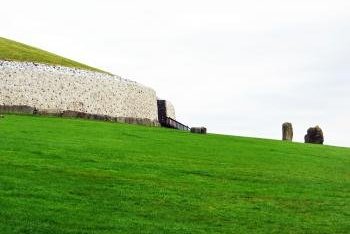
Within an hour of leaving Dublin's international airport, my friends and I found ourselves within the beautifully bucolic Boyne River valley, home to the neolithic history encapsulated in the Brú na Bóinne - Archaeological Ensemble of the Bend of the Boyne World Heritage Site. We arrived at the visitor center as soon as it opened in the morning, and were thus able to secure a visit on the earliest tour to Newgrange tomb. The visitor center is an excellent way to prepare for a visit to Newgrange, with exhibits on the life of local inhabitants from around 3200 B.C., and a replica of the tomb passage and chamber that is wheelchair accessible. After we toured the visitor center, we boarded a bus which took us to Newgrange tomb, which sits atop a hill overlooking the verdant Boyne River valley. I enjoyed the walk back in time through the passage to the inner chamber, where the guide helpfully turned off the lights and provided a simulation of what the light would look like when the sun is lined up with the tomb entrance at the winter solstice. I also appreciated the stone art, including the spirals carved into rocks inside and outside the tomb. A visit to Brú na Bóinne is an excellent introduction to the rich history of the Emerald Isle.
Logistics: Brú na Bóinne is situated in the Irish countryside, and is most easily reached by automobile or other private transportation. Day tours with tour companies departing from Dublin …
Keep reading 0 comments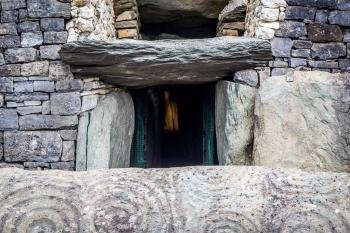
There are a few places that make up the site but I decided to see it by visiting Newgrange - which is the easiest to get to, the most popular and (probably) the most interesting.
I found the easiest way to get there without a car was to jump on one of the coach tours that go out there each day. It also means you are guaranteed a spot in a group tour of the site when you arrive. You need to go in with a guide so if you just turn up, you may have to wait until there's a spot.
The site itself is quite interesting from the outside, although it was 'reconstructed' in a way that experts thought it would have looked. The real highlight, though, is when you go inside. The detail in the rock carvings is incredible and it has been so well preserved after all these millennia. There's a good demonstration of how the sun would look during the solstice - gosh it would be quite an experience to be inside the cavern for that!!
Keep reading 0 comments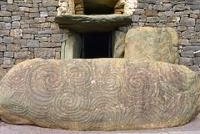
I visited this WHS in July 2012 and was expecting Newgrange to be the highlight of my trip. By all means, Newgrange is well kept and the triathlon entrance, spiral engravings and the watertight interior make it an incredible site. The young local guides are making a good job there. They also switch off the light inside to simulate the winter solstice sun rays creeping in and lighting the whole place. However, the surprise and real highlight of my visit was Knowth. Knowth comprises a series of well-restored prehistoric passage tombs which really show that this place was considered to be a very special and important place. I could notice the many similarities with the neolithic temples of Malta and indeed several studies were made and are still being made to compare these extraordinary sites. In the main passage tomb of Knowth, an ornate flint macehead or pendant was found and it can be seen in the National Museum of Archaeology in Dublin. It is almost impossible to even make a scratch on flint without machinery but incredibly enough this artefact was neatly engraved and decorated!
Keep reading 0 comments
Older then the pyramids and still holding up fine...of course with a little restoration on the side. The Bend of the Boyne is a fabulous archaelogical site, and is truly one of the highlights of any trip to Ireland.
Despite crowds at the visitors center and tour buses aplenty,the actual site is not at all overrun; with only a limited amount of tourists allowed in each day.
The site itself is composed of three section: Newgrange, Knowth and Dowth. Dowth is not open to the public.
I visited both Newgrange and Knowth, and while I must agree with the reviews below that state that Newgrange is phenomenal, I must put in that Knowth is even better.
Newgrange is composed of a single (albeit, large and spectacular) burial mound, but Knowth has over 40 different burial mounds. Furthermore, the biggest mound at Knowth is 33% larger then that at newgrange. Added to this, Knowth also contains remains of medieval cellars (Souterrains) which are interesting.
But what really sets Knowth apart from anything else is the rock art. Dating from 5000 B.C., there is a phenomenal amount of scribbled swirls, loops, and crescents on the rocks that surround the base of the largest mound. Truly a treasure.
One of the most interesting things about the Bend of the Boyne is the difference between Newgrange and Knowth. Both were restored in the 60s and 70s, but by different archaeologists with different ideas of how it originally looked. The glittering white quartzite that makes …
Keep reading 0 comments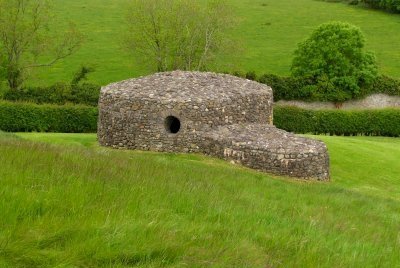
On a cloudy Saturday, I took a bus tour from the Dublin bus station to the Boyne Valley. The first half of the tour was dedicated to early Christian Ireland. First, we admired the 10th-century crosses at Monasterboice. After that, we visited Ireland's first Cistercian Abbey (Old Mellifont). A very articulate female guide made this part of Irish history come alive.
In the early afternoon, we finally arrived at the main destination of the day: Newgrange, part of the Archeological Complex at the Bend of the Boyne.
Sightseeing there started at the Visitor Center, where a simple exhibition is shown about the daily life of the people who build the structures. The explanations are very specific about the site predating Egypt's Pyramids and Stonehenge (that last one must give the Irish some extra pleasure). When I checked the dates of some other prehistoric WHS (of which there are many), the funerary monuments of the Boyne Valley are from about the same age as the first Megalithic Temples of Malta and the Heart of Neolithic Orkney.
Access to the tombs is only allowed with a guide. A small bus takes you there, the mounds are situated amidst agricultural lands. Only little is known, much speculation surrounds this site. The stones that were used come from different areas, some from quite a distance. The way they are presented now is the result of the restorations of Professor O'Kelly in the 1960s and 1970s, a reconstruction that has been criticized.
… Keep reading 0 comments
Dowth, Knowth, Newgrange in the valley of the Boyne. Tara. My friend & I travelled to Ireland for 2 weeks in July of 2002. We started at Newgrange and then went on to Carrowmore, Carrowkeel, the Burren. I highly recommend visiting them in the sun or rain. Rain makes them even more special. High clearance vehicle for Carrowkeel. Visit www.megalithomania.com for pics and info on megalithic sites throughout Ireland.
Keep reading 0 comments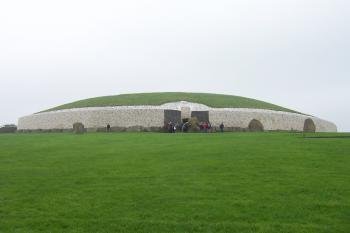
This was my second Neolithic site in a week and it had Stonehenge to match up to, and I can safely say that it did! I am not really a big prehistoric site fan but this was pretty spectacular. We were told that the main passage-grave Newgrange is actually the oldest building in Europe, and after I have racked my brains I can't think of anything older! It predates Stonehenge by a good 1,000 years. The outside is much restored but it has been done very well, and many of the other sites have not been touched so you do have some idea of what it looked like pre-renovation. The inside though has been pretty much untouched since being completed about 5,200 years ago impressive stuff! The burial tomb in the centre is actually quite a calming place after the tight squeeze through the passage, a few of the stones have intricate Celtic carvings especially on the right hand side as you enter. Inside you have a brief display of the course of the sun as is seen on the winter solstice, which adds to the experience. Unfortunatly I was not able to get to the other two main sites at Knowth and Dowth which show what the sites would have looked like before the extensive restoration.
I visited the site on a day trip from Dublin, and despite having a bit of a fear of organised tours and the herding that comes with them I had a really good …
Keep reading 0 comments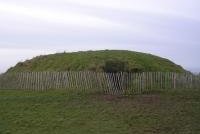
Blessed with sunny December weather, I made a day trip to the Bend of the Boyne during a visit to Dublin in December 2004. Not wanting to have the hassle of driving, I chose to join a tour that would hit some of the highlights for me. Unfortunately, it was the winter solstice, so Newgrange was reserved for dignitaries and other more important people than I. This meant, however, that the tour was able to go more in depth into some other passage graves, ancient abbeys, and other Stone Age sites, such as Four Knocks and the Hill of Tara. Very pleasant way to recover from a Dublin-induced hangover.
Keep reading 0 comments
